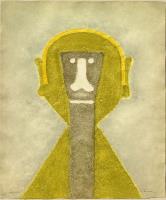
Rufino Tamayo
Internationally known, Rufino Tamayo was one of Mexico's greatest artists. His intellect, passion, and intensity helped establish Tamayo as one of the finest artists in the world. He was a universal humanitarian, leader of the Hispanic world, renegade of the muralist movement, true discoverer of new possibilities in abstract art, and a genius avant-garde visionary of artistic expression on the international plane.
The art of Rufino Tamayo awakens different, often contrasting feelings, On the one hand, Tamayo's art is deeply personal, his fantastic figures express his honesty, as well as his artistic intent. On the other hand, his reflections are universal, and they enrapture us all, no matter what our nationality, race, or creed. An inherently humble man, Tamayo himself never escaped misfortunes. Like Juarez, the other great Oaxacan, he left his home at a young age to discover the world with his guitar, his sandals, and the desire to absorb life firsthand.
Rufino Tamayo was born in 1899 at Oaxaca, Mexico. After his parents, who were Zapotecs, died when he was eight years old, he was raised by his aunts who moved him to Mexico City. After attending painting classes at the San Carlos Art School, he preferred to study the great contemporary art movements, Impressionism, Cubism, and Expressionism on his own. Tamayo was appointed the head of the ethnographical drawing section of the Museum of Anthropology of Mexico in 1921, which, since the Revolution in 1920, has been classifying the material of ancient civilizations. His first one-man show in 1926 integrated traditional Pre-Colombian forms with the achievements of contemporary painting. In 1933 his first fresco was commissioned for the Academy of Music.
In 1950, after his return from exhibiting in Paris, Brussels, Rome, and Venice, he began to work on over 645 square feet of wall in the Palacio de Bellas Artes in Mexico City, where until then, only Orozco and Rivera had been invited to work. He was awarded first prize at the Sao Paulo Biennale in 1953 and received the International Prize of the Guggenheim Foundation in 1960.
After that, Tamayo lived not only in Mexico City but in New York and Paris as well. He tasted the splendor and fast pace of the world's biggest cities. He gained great wisdom and perspective, was described as painting out his wisdom "armed with his truth", and underscored by museum attention around the globe. As such, the art of Rufino Tamayo will endure. In his view, a work of art should not be judged by its resemblance to nature. Instead, it exists as an independent entity with a life and problems of its own. Tamayo's magnificent gift was to demonstrate and conceal, to show the hidden and hide the evidence in an ultimate demonstration of his grace and gentleness, all with the vividness of color that resulted from his studies of clothing worn by Mexican Indians. He had a lifelong fascination with luminous color, varied textures, and modernist flatness, and this interest was borne out in his representation of humanness. In going back to the origins of expressive idiom through an instinctively poetic vision of reality, Tamayo found, by sheer skill and simplicity, the sincerity of the popular artist.